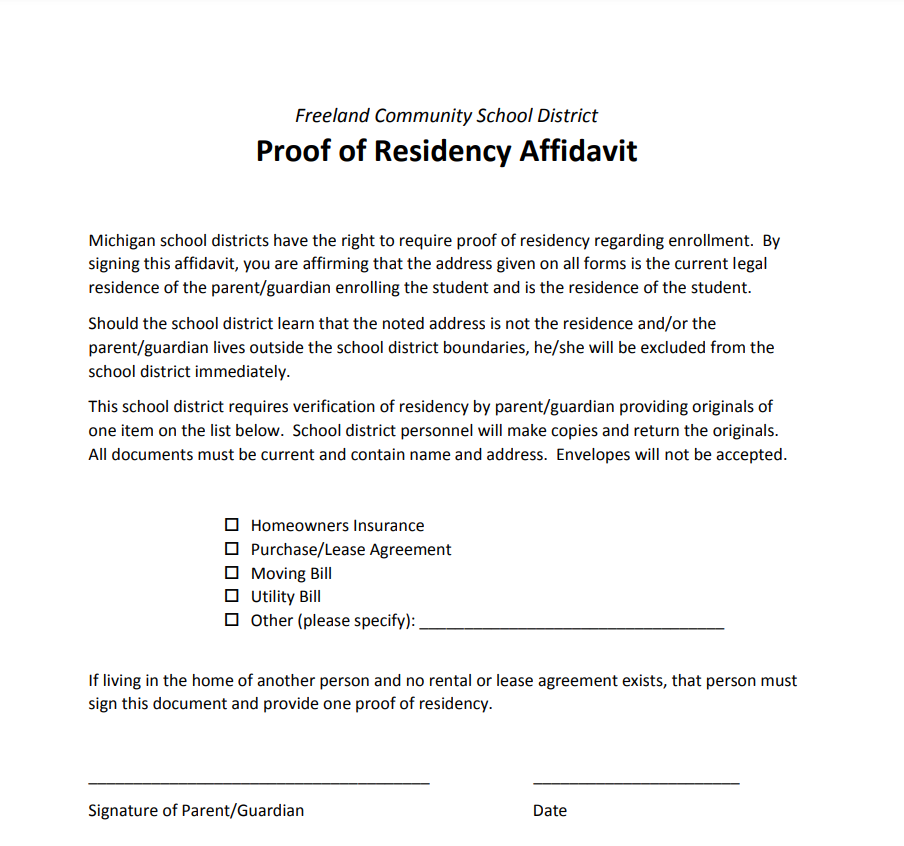Michigan Residency Affidavit Form – You must turn in this affidavit form if you intend to petition for residency in Michigan. This document serves as proof of residency. It is utilized to demonstrate residency to particular governmental entities or school districts. This form must be submitted along with your residency documentation. The form is simple to fill out and is accessible online. Learn more about the form and documentation you must submit by reading this article.
Specifics of a residence affidavit
In order to prove your residency in the state of Michigan, you must submit an affidavit of residency. Common uses of the document include school registration, in-state college tuition rates, child custody disputes, and driver’s license applications. For the purpose for which it is being used, the appropriate address should be included. You must use the correct address for each residence if you have more than one.
The form is available for download in a variety of file types, including ODT, PDF, and word processing files. The form, which needs to be completed and signed, can be downloaded from a browser. The form has areas for the signer’s name, the date they signed, and their residency documentation. Information on the signatory party should be included as well. Depending on the kind of document, each state may have a different form.
Every year at the beginning of the academic year, the Affidavit of Residency for Michigan must be updated and include the current address. According to Michigan law, failure to do so can lead to felony charges. Affidavits of residency are crucial to have on hand since the state has the power to remove your child from school if they are unable to comply with residency rules.
documents that can be used to demonstrate your residency
There are a number of documents that can be used to demonstrate Michigan residency. A nice illustration of a residence proof document is a letter. Applications for jobs usually need to include it, and it is notarized. The DMV also uses it to verify residency. In some cases, a family member may apply for residency on your behalf, but you must provide documentation of the connection. Your social security number must be included in the proof of residency document.
To verify residency, you’ll need a current Michigan driver’s license or other form of photo identification with your current address. Additionally required is a current Michigan car registration. It’s crucial to remember that for the residency status to be legitimate, this must be current. Having a spouse who works in Michigan necessitates also having your spouse’s passport. Residency can also be demonstrated by a marriage certificate or property tax receipt.
The parents of the dependent student must present documentation of their legal divorce, separation, or remarriage. They will be regarded as an out-of-state student if they fail to do so. On the other hand, the student will be regarded as an in-state student if they have finished their junior and senior years of high school in Michigan. However, if the dependent kid has not yet registered for a Michigan high school that is accredited, they will be regarded as an out-of-state resident.
school districts that demand residency affidavits
Some school districts in Michigan demand affidavits proving residency. They are a great tool for parents to demonstrate that their children actually reside at the address on their license. Although the regulations differ from district to district, several different types of documents can typically be used to verify residency. These can include receipts for rent payments, energy bills, property tax bills, a mortgage document, or even a letter from a parent’s employer on business letterhead. It’s crucial to ask the school district what paperwork they need before proceeding.
For any parent, getting the required papers is essential. Whether it is for a minor’s enrollment or in-state tuition for a college or university, many colleges need proof of residency. A third party must fill out some of these paperwork. These files may be in Open Document Text, Microsoft Word (.docx), or Adobe PDF format (.odt).
Download Michigan Residency Affidavit Form 2022
